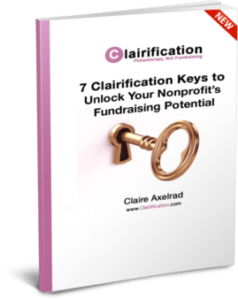
Survival Depends on Collective Commitment and Deep Support
Too often, fundraising is relegated to an administrative function rather than a mission-central function.
It’s viewed as a ‘necessary evil.’ As a result, either no one embraces it as central to their job description, or someone is hired and shunted off to a corner to do the ‘dirty work.’
Others don’t necessarily feel a need to cooperate or support the fundraising effort.
It’s ancillary, not primary. A cost center, not a revenue center. In fact, I’ll often hear executive directors or board members tell me, with some pride and a soupçon of defensiveness: “We can’t spend money on development staff right now; anything extra we have must go into the mission!”
As if fundraising doesn’t support the mission?
Seriously, that’s the entire purpose of what nonprofits call ‘development’ (aka fundraising and marketing). It derives its purpose from ends served. It’s never an end in itself. What this so-called ‘mission first’ logic fails to acknowledge is everyone associated with your nonprofit is guided by a ‘mission first’ philosophy and has a collective stake in your nonprofit’s survival. And for most nonprofits, survival – or at least some level of mutually desired success – depends on philanthropy.
It takes a dedicated village to generate sustainable, meaningful philanthropy.
When fundraising is treated as an afterthought, relegated to the development committee, or delegated to a single staff member, it disenfranchises a huge segment of folks who care about sustaining the cause. This means you’ll leave money on the table and fail to realize your mission potential.
I’ve found four ways nonprofits don’t wholeheartedly commit to fundraising. They all have to do with typical priorities that aren’t standing them in good stead.
4 Reasons You’re Failing to Achieve Your Nonprofit’s Fundraising Potential
1. Failure to put in place a dedicated development staff team to cover all bases.
Penny-wise and pound-foolish’ yields fundraising pennies.
No doubt you’ve heard the old adage “you have to spend money to make money.” It’s true. The more you invest, the better return you’ll get. Of course, you must live within your means and find a workable balance. But don’t give up on proactively seeking out resources to put in place a team effort that will take you to the next level. If you’ve not done so already, consider:
- Hiring a development director.
- Dedicating a staff person to focus on individual gifts, which according to Giving USA accounted for 75% of all philanthropy last year.
- Dedicating a major gifts officer to focus on the area that, on average, brings in 80 to 95% of total contribution income from individuals.
- Hiring a staff person to support that development director, annual individual gifts and major gifts officer.
- Hiring a staff person to generate foundation grants.
- Hiring a staff person to produce marketing communications to warm prospective donors up for the fundraising ask.
- Putting in place any other range of essential functions to support attracting and retaining donors (e.g., database manager; digital marketing/fundraising manager; donor relations coordinator, and so forth).
While it may not be within your reach to hire different people to fulfill all these critical functions, at the least you must include these responsibilities in someone’s job description– ideally spreading the tasks out, say, among a development staffer, executive director, program staffer, administrative support staffer and/or a marketing staffer. Try to keep in mind, however, you’ll reap what you sow.
If you’re skimping on essential personnel, trying to do this all with just one chief cook and bottle washer, or are ignoring some of these fundamentals, it’s time to rethink your priorities.
Or suffer the heartbreaking consequences.
Mission is not possible without money to move it forward.
2. Failure to develop a ‘fundraising board’ vs. a ‘community board.’
Unless your board actively works towards advancing your mission through making contributions to your financial bottom line, you’ll be at a disadvantage.
If you don’t think ahead, the future will nonetheless arrive. Without you. Time keeps moving. If you want board members to do more than simply hang out and rest on their laurels, you have to let them know. It’s hard to ask others to do what your board isn’t willing to do. This means giving specific assignments to help with revenue generation, plus ongoing hand holding and support to empower their experience. Consider:
- A shift from pussyfooting around the subject to embracing fundraising warmly.
- Letting board prospects know when you recruit them that part of their service includes giving and getting according to their ability.
- Making it clear board service incorporates a dual responsibility of governance and financing, and they cannot abdicate either role.
- Assuring ‘development’ is a standing committee of your board, and that just because you have a development committee does not mean individual members are absolved of their financing role.
- Mandating that development be included on every board meeting agenda.
If you’re not putting development front and center in your board recruitment and ongoing development process, it’s time to rethink your priorities.
Or suffer the heartbreaking consequences.
A board that does not lead in fundraising generates too few followers.
3. Failure to develop an organization-wide philanthropy culture.
The heart of the matter is love and values, all oriented toward the public good.
Philanthropy, after all, literally means “love of humankind.” And sustainable philanthropy takes a village. It’s a communal endeavor. Not just from the outside/in, but from the inside/out. Consider how you might:
- Prioritize this from top leadership down (begin with the E.D., Executive Management Team, Board Chair and Board Committee Chairs).
- Express this philanthropy-centered culture as a written goal in your strategic plan.
- Create a collaborative environment to eliminate departmental silos.
- Hold staff and board orientations and ongoing meetings where culture of philanthropy is on the regular discussion agenda.
- Regularly express meaningful gratitude to your team players and stakeholders, both internal and external.
- Incorporate transformative vision and values into individual job descriptions so everyone is on board with your common, shared raison d’être.
- Include donors in your core mission, asking not just what they can do for you but what you can do for them.
- Commit to help constituents experience the joy of giving, understanding it is through you they will achieve their most meaningful work.
If you’re failing to embrace fundraising as part of everyone’s job, it’s time to rethink your priorities.
Or suffer the heartbreaking consequences.
If everyone shares the same enemy, and is committed to obliterating the same foe (be it hunger, poverty, disease, injustice, cruelty, illiteracy, or environmental destruction, etc.), it’s your obligation as an organization to facilitate philanthropy – to help folks (staff, volunteers, donors and your community) fight this fight on all fronts.
Without goodwill and a culture of philanthropy, you’re not going to achieve anywhere near as much as you could or should.
4. Failure to tell relevant emotional stories that make your mission relevant.
Nonprofits exist to solve problems — and there’s a story behind every one.
These problems are generally resolved with the support of people who care about these problems, and also want to see them fixed. But, first they have to see and agree to the troubling issue. Which means you must tell a tale that intentionally draws folks into your narrative. To do this effectively, consider:
- Speaking to people’s hearts, not their heads.
- Emphasizing impact, not money.
- Drawing attention to specific, compelling stories of people, places, animals and ideals, not emotionally-dulling facts, figures and processes.
- Focussing on the motivations people might have to ensure you continue to exist.
- Developing systems for collecting and sharing impact stories that demonstrate what might happen were you to be unable to grow or, even worse, cease to exist.
- Getting out in the field to visit your programs and see first-hand your story in action.
- Talking to donors to learn why they are so invested with your cause, and what stories resonate with them.
- Taking the time to intentionally structure your stories for maximum impact.
If you’re failing to articulate and relate a persuasive emotional story, it’s time to rethink your priorities.
Or suffer the heartbreaking consequences.
Don’t fall short of your fundraising power. Sure, donors will give drop-in-the-bucket token gifts to fact-based appeals. But they’ll give transformative gifts when drawn into a story with which they can connect.
You must describe your story – aka your ‘case for support’ — in such a compelling way the donor wants to jump into it and become the hero that gives the story a happy ending.
Summary and Next Steps
If you want to achieve remarkable results, rather than simply limp along, heed the advice of innovative thought-leader Seth Godin:
“I can’t afford it.”
“I don’t have the time.”
…almost always means, “this is not a priority.”
When we care, it’s amazing how much we can get done. One way to choose to care is to be clear about your priorities, which means being clear in your language.
And so we can say to ourselves, “I’d love to do that, but it’s not a priority.”
Remarkable work is usually accomplished by people who have non-typical priorities.
— Seth Godin
1. Determine the development staff and infrastructure you need, and prioritize making this critical investment in your future success.
2. Think carefully about how much a strong, committed fundraising board could help you accomplish and prioritize taking steps to move towards this place of strength.
3. Imagine a philanthropy culture where everyone helps each other as a matter of course, and prioritize making this culture a reality.
4. Revisit the core story of your mission, break it down into components that mirror your key initiatives, and demonstrate your impact.by finding stories to show and tell.
For each of these four areas, ask yourself and others:
- What would it take?
- Where should we focus?
- How might we find the resources?
- Who needs to be involved?
- When shall we target to accomplish each of these objectives?
What do you think? Doable? What holds you back? Please share in the comments below.
Get the 7 Clairification Keys!
 Unlock your nonprofit’s fundraising potential through a series of “clairifying” worksheets and exercises.
Unlock your nonprofit’s fundraising potential through a series of “clairifying” worksheets and exercises.
- Values.
- Stories.
- Brand.
- Social Channels.
- Support Constituencies.
- Engagement Objectives.
- Resources and Systems.
Learn more HERE. As with all Clairification products, this comes with a 30-day 100% refund guarantee. If you’re not happy, I’m not happy.
Image: Yoda sculpture, Imagination Park, San Anselmo California.





